When it comes to communicating with your poodle, think of it as a silent dance where every movement, bark, and tail wag holds a significant message waiting to be decoded. By understanding the intricacies of your poodle's communication style, you can forge a deeper connection based on mutual understanding and respect. Each interaction is a chance to strengthen your bond and unravel the mysteries of your fluffy companion's world. So, are you ready to uncover the secrets of effective communication that will bring you and your poodle closer together in ways you never imagined?
Key Takeaways
- Understanding body language and verbal cues strengthens communication.
- Consistency in tone and rewards builds trust and cooperation.
- Positive reinforcement techniques shape behavior effectively.
- Training, patience, and positive affirmations foster a strong bond with your Poodle.
Understanding Your Poodle's Body Language

If you want to deepen your bond with your poodle, understanding their body language is crucial. Your poodle communicates a lot through its body language – from the wagging of its tail to the position of its ears. When your poodle is happy and friendly, you may notice its tail wagging, ears perked up, and a relaxed posture. On the other hand, signs of stress in your poodle might include lowered ears, a tucked tail, or avoiding eye contact.
Establishing Clear Verbal Cues
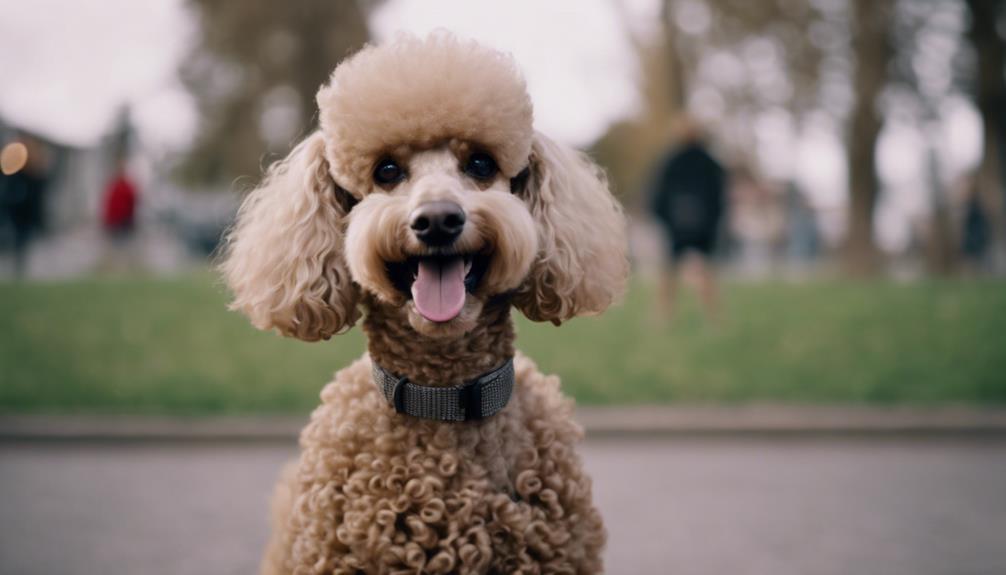
Understanding your poodle's body language lays a strong foundation for establishing clear verbal cues in your communication with them. Poodles are incredibly intelligent and responsive to verbal cues, making it crucial to communicate effectively. Utilizing specific words and tones consistently helps poodles grasp commands and expectations with clarity. When you pair positive reinforcement with verbal cues, you create a powerful link between words and desired behaviors in your poodle. Incorporating verbal cues into training sessions not only keeps your poodle engaged but also taps into their need for mental stimulation, keeping them motivated. By being precise in your verbal communication, you enable your poodle to differentiate between various commands, leading to successful training outcomes. Remember, in the art of communicating, a good book is the one where the dog becomes a willing participant in the dialogue you share.
Importance of Consistent Tone
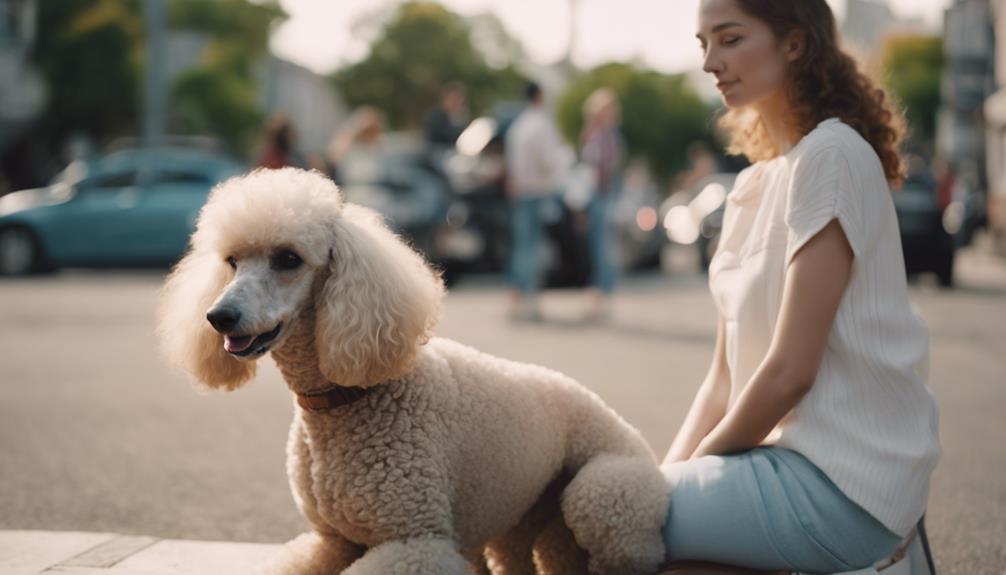
When communicating with your poodle, maintaining a consistent tone is crucial for establishing clear expectations and reinforcing training cues effectively. Vocal inflections play a significant role in conveying emotional cues to your poodle. Poodles are sensitive to changes in tone, so consistency in your voice pitch is essential for better understanding and responding to commands. Training consistency is key to a harmonious communication process with your poodle. By using a steady tone, you promote positive reinforcement and reduce confusion during training sessions. Varying tones may lead to mixed signals, hindering the learning process and potentially causing stress or anxiety in your poodle. Creating a stable and predictable environment through a consistent tone fosters trust and cooperation, enhancing the bond between you and your poodle. Remember, your poodle looks to you for guidance, and a steady tone helps them feel secure and supported in their training journey.
Using Positive Reinforcement Techniques

When training your poodle, remember to reward good behavior consistently. By offering treats, praise, or toys, you can reinforce desired actions effectively. Practice patience and persistence to create a positive learning environment for your furry companion.
Rewarding Good Behavior
To reinforce good behavior in your poodle, utilize positive reinforcement techniques such as rewarding them with treats, praise, or toys. Treat motivation is an effective way to encourage desirable actions and reinforce positive behaviors. When your poodle displays the behavior you want to see, promptly reward them to shape their actions positively. This method, known as behavior shaping, helps your poodle understand what behaviors are desired from them. Through reinforcement training, your poodle learns to associate good behavior with pleasant outcomes, making training sessions enjoyable and productive. Consistency in rewarding good behavior is key to solidifying these positive habits and building a strong bond based on trust and cooperation. By using these techniques, you can foster long-lasting behavioral changes in your poodle and ensure a happy and well-adjusted pet.
Consistency Is Key
For effective communication and training with your poodle, maintaining consistency in using positive reinforcement techniques is paramount. Training consistency is key in reinforcing good behavior and fostering a strong communication bond with your furry companion. By consistently rewarding desired behaviors with treats, praise, or toys, you help your poodle understand what is expected of them. This repetition reinforces positive behaviors, making it more likely for your poodle to repeat them. Consistent application of positive reinforcement techniques is essential for effective learning and response to commands. By staying consistent in your approach, you establish clear expectations and create a harmonious environment for both you and your poodle to communicate effectively and build a trusting relationship.
Patience and Persistence
Maintaining patience and persistence in utilizing positive reinforcement techniques is crucial when communicating effectively with your Poodle. When training your Poodle, remember these key points:
- Training Progress: Monitor your Poodle's progress closely and celebrate small achievements to keep motivation high.
- Reinforcement Techniques: Consistently use treats, praise, and positive affirmations to reinforce desired behaviors effectively.
- Behavior Modification: Understand that behavior modification takes time; be patient, consistent, and gentle in guiding your Poodle towards the desired behavior.
Recognizing Stress Signals
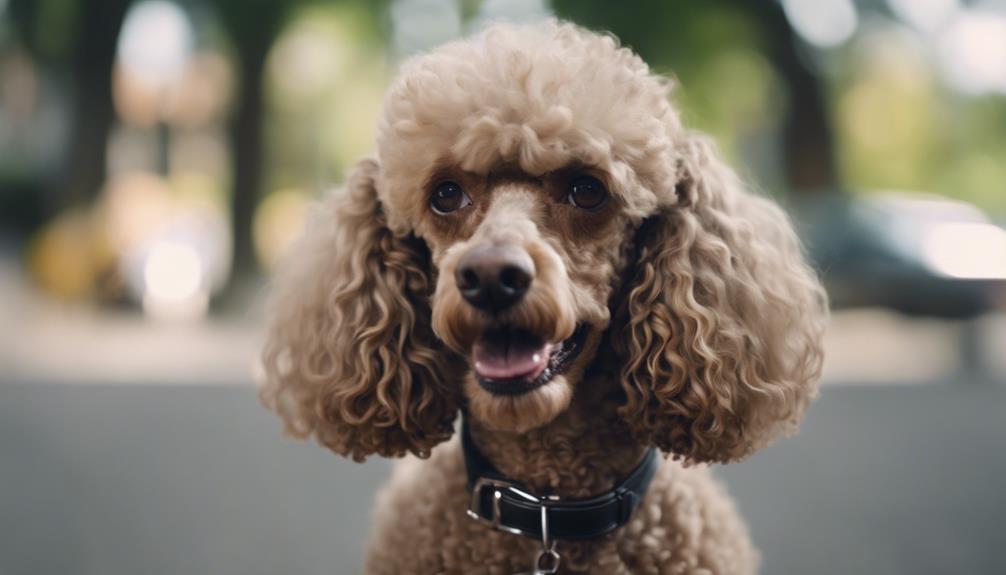
Recognizing stress signals in your poodle is crucial for maintaining a healthy and positive relationship with your furry companion. Poodles, like humans, can experience anxiety and stress, and it's essential to be able to recognize the signs. Watch for behaviors like excessive panting, pacing, trembling, or hiding, which may indicate stress in your poodle. Additionally, pay attention to subtler cues such as lip licking, yawning, avoiding eye contact, flattened ears, raised fur, or a tucked tail. Changes in appetite, shedding, or unusual vocalizations can also be signs of stress in your pet. To help your poodle manage stress, consider implementing calming strategies such as creating a safe and quiet space, engaging in soothing activities like gentle petting or massage, and maintaining a consistent routine. By understanding and responding to your poodle's stress signals, you can foster a deeper bond and ensure their well-being.
Building Trust Through Communication

To build trust with your poodle through communication, it's crucial to pay attention to their body language and vocal cues. By establishing consistent routines and clear boundaries, you create a sense of security that strengthens your bond with your poodle. Remember, communicating calmly and confidently, using rewards and praise, will enhance trust and understanding between you and your furry companion.
Trust and Body Language
Building trust with your poodle starts with consistent body language cues such as eye contact, posture, and facial expressions. To create a strong bond with your furry companion, consider the following:
- Maintain Eye Contact: Establish trust by looking your poodle in the eyes, showing attentiveness and care.
- Watch Your Posture: Stand or sit in a relaxed manner to convey a sense of calm and confidence to your poodle.
- Use Gentle Facial Expressions: Smile softly and avoid frowns or stern looks to communicate kindness and approachability.
Consistent Routines for Trust
Developing consistent routines for your poodle is essential in fostering trust and strengthening your communication bond with them. Training consistency and routine stability lay the foundation for a trusting relationship. By providing predictability and setting clear boundaries, your poodle feels secure and understands what is expected. This predictability leads to behavior trust and aids in communication building. Positive reinforcement techniques, like rewards and praise, further enhance trust. To illustrate the importance of consistent routines, consider the following table:
| Consistent Routines for Trust | Benefits |
|---|---|
| Regular feeding schedule | Predictability |
| Daily walking routine | Stability |
| Establishing rules | Reinforced communication |
| Positive reinforcement | Enhanced trust |
Tailoring Commands to Your Poodle
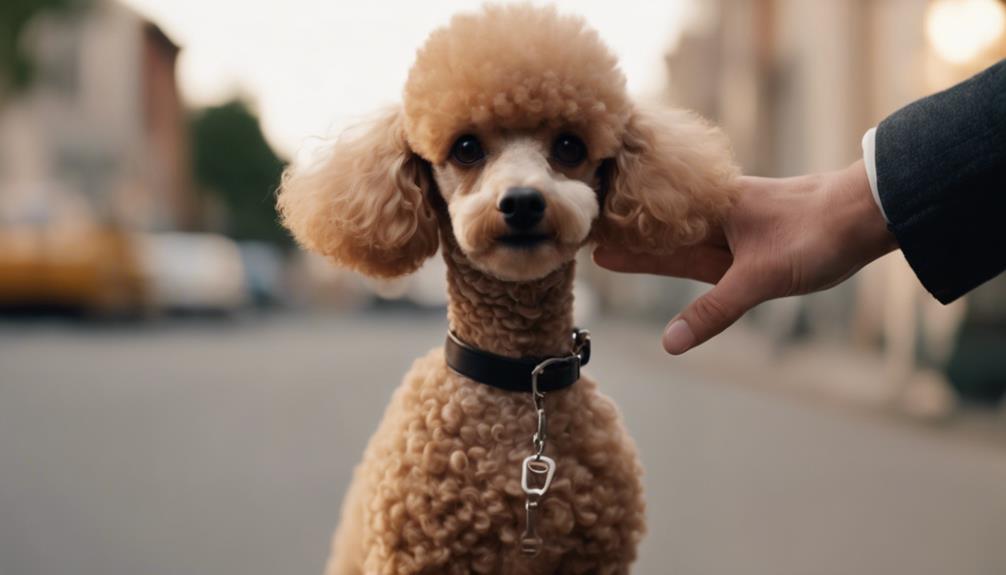
Understanding your poodle's individual characteristics is crucial when tailoring commands to suit their unique needs and abilities. To effectively communicate with your poodle, consider the following:
- Reward Based Training Techniques: Utilize positive reinforcement such as treats, praise, or toys to motivate and reinforce desired behaviors in your poodle.
- Mental Stimulation Exercises: Engage your poodle's sharp mind with interactive toys, puzzle games, or training sessions to keep them mentally stimulated and focused.
- Playful Communication Strategies: Incorporate fun and engaging activities like interactive play, hide-and-seek games, or agility exercises to build a strong connection and trust with your poodle.
Incorporating Non-Verbal Signals
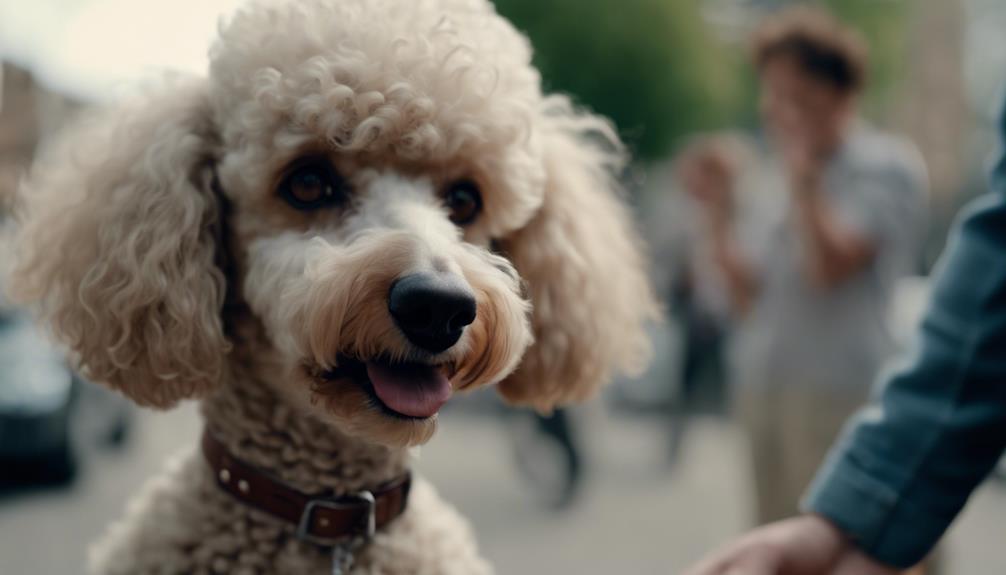
To effectively convey your intentions to your poodle, integrating non-verbal signals into your communication is essential. Poodles are highly attuned to visual cues, making silent commands and connection through gestures vital components of your interaction. Consistent hand signals can significantly assist in training your poodle to understand commands more efficiently. Establishing eye contact and using hand gestures not only aids in training but also fosters a strong bond and clear communication with your poodle.
Your poodle's sensitivity to your tone of voice emphasizes the importance of incorporating non-verbal signals to convey emotions and intentions effectively. By utilizing non-verbal cues alongside verbal commands, you can enhance mutual understanding and strengthen the connection in your human-dog relationship. Remember, poodles respond well to body language and facial expressions, so be mindful of the signals you are sending. Through the integration of non-verbal signals, you can create a harmonious and enriched communication experience with your beloved poodle.
Enhancing Bonding Through Communication
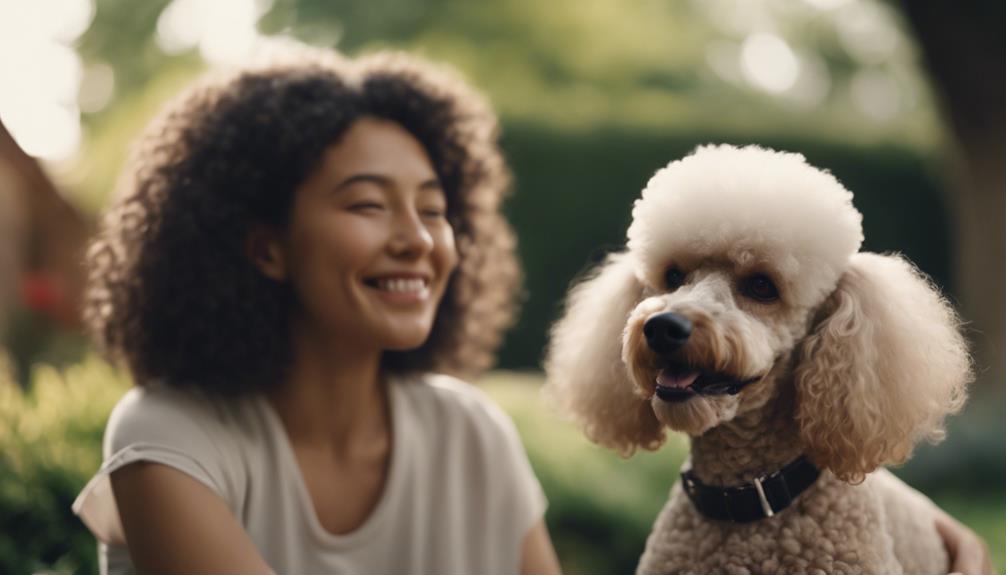
Establish a strong bond with your poodle through effective communication techniques that enhance mutual understanding and connection. Poodles, with their high intelligence, are eager to communicate with you. Strengthen your bond and improve obedience by incorporating the following activities:
- Interactive playtime: Engage in games like fetch or hide-and-seek to bond with your poodle while keeping them mentally and physically active.
- Mental stimulation exercises: Challenge your poodle with puzzle toys or obedience training to provide mental enrichment and strengthen your communication.
- Bonding activities: Spend quality time together through activities like leisurely walks or cuddle sessions, promoting a sense of closeness and trust between you and your poodle.
Frequently Asked Questions
How Do You Communicate With Your Dog I Love You?
To communicate "I love you" to your poodle, show affection through body language cues like gentle petting and cuddling, use soothing vocal tones, and engage in bonding activities such as playtime, walks, and quality time together.
How Do You Communicate Your Dog?
When communicating with your dog, pay attention to body language cues, vocal tone, and training techniques. Consistency, positive reinforcement, and understanding individual needs are key. Tailor your approach to build a strong connection.
What Are the 4 Major Methods of Communication That Dogs Use?
Dogs communicate primarily through body language cues, verbal commands, eye contact signals. Understanding these signals helps you connect with your poodle. Pay attention to their movements, listen to their barks, and engage with their gaze to strengthen your bond.
How Can I Speak Better With My Dog?
To speak better with your dog, observe body language cues, adjust vocal tone for different commands, and use treat rewards for positive reinforcement. Consistent practice, patience, and empathy will strengthen your bond and communication skills.
Conclusion
As you continue to hone your communication skills with your poodle, remember that patience and understanding are key. By paying attention to their body language, using clear verbal cues, and providing positive reinforcement, you can strengthen your bond and create a harmonious relationship. Trust your instincts and remember that every interaction is an opportunity to enhance your connection with your furry companion. Enjoy the journey of building a strong and fulfilling relationship with your poodle through effective communication.
